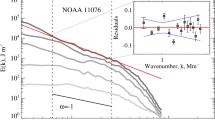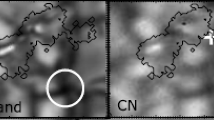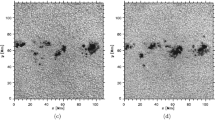Abstract
We analyse data from Hinode spacecraft taken over two 54-minute periods during the emergence of AR 11024. We focus on small-scale portions within the observed solar active region and discover the appearance of very distinctive small-scale and short-lived dark features in Ca ii H chromospheric filtergrams and Stokes I images. The features appear in regions with close-to-zero longitudinal magnetic field, and are observed to increase in length before they eventually disappear. Energy release in the low chromospheric line is detected while the dark features are fading. Three complete series of these events are detected with remarkably similar properties, i.e. lifetime of ≈ 12 min, maximum length and area of 2 – 4 Mm and 1.6 – 4 Mm2, respectively, and all with associated brightenings. In time series of magnetograms a diverging bipolar configuration is observed accompanying the appearance of the dark features and the brightenings. The observed phenomena are explained as evidencing elementary flux emergence in the solar atmosphere, i.e. small-scale arch filament systems rising up from the photosphere to the lower chromosphere with a length scale of a few solar granules. Brightenings are explained as being the signatures of chromospheric heating triggered by reconnection of the rising loops (once they have reached chromospheric heights) with pre-existing magnetic fields, as well as being due to reconnection/cancellation events in U-loop segments of emerging serpentine fields. The characteristic length scale, area and lifetime of these elementary flux emergence events agree well with those of the serpentine field observed in emerging active regions. We study the temporal evolution and dynamics of the events and compare them with the emergence of magnetic loops detected in quiet Sun regions and serpentine flux emergence signatures in active regions. The physical processes of the emergence of granular-scale magnetic loops seem to be the same in the quiet Sun and active regions. The difference is the reduced chromospheric emission in the quiet Sun attributed to the fact that loops are emerging in a region of lower ambient magnetic field density, making interactions and reconnection less likely to occur. Incorporating the novel features of granular-scale flux emergence presented in this study, we advance the scenario for serpentine flux emergence.









Similar content being viewed by others
Notes
In this paper we will refer to NFI Na i D Stokes data as NFI Stokes I and NFI Stokes V/I, not to be confused with the BFI Ca ii H filtergrams.
See this sequence in movie format as an electronic supplement to this paper.
Initial times Δt=0 are set as corresponding to the first appearance of the dark feature in all the analysed sequences.
See this sequence in movie format as an electronic supplement to this paper.
See this sequence in movie format as an electronic supplement to this paper.
Running difference images of longitudinal magnetograms generated every 2 min helped us to identify the magnetic footpoints, especially in those places where the emerging magnetic concentrations overlap the pre-existing fields, making their visualisation more difficult.
References
Archontis, V.: 2008, J. Geophys. Res. 113, A03S04.
Bernasconi, P.N., Rust, D.M., Georgoulis, M.K., Labonte, B.J.: 2002, Solar Phys. 209, 119.
Bruzek, A.: 1967, Solar Phys. 2, 451.
Bruzek, A.: 1969, Solar Phys. 8, 29.
Centeno, R., Socas-Navarro, H., Lites, B., Kubo, M., Franz, Z., Shine, R., et al.: 2007, Astrophys. J. 666, 137.
Cheung, M.C.M., Schüssler, M., Tarbell, T.D., Title, A.M.: 2008, Astrophys. J. 687, 1373.
Deng, Y.Y., Schmieder, B., Engvold, O., DeLuca, E., Golub, L.: 2000, Solar Phys. 195, 347.
de Wijn, A.G., Lites, B.W., Berger, T.E., Frank, Z.A., Tarbell, T.D., Ishikawa, R.: 2008, Astrophys. J. 684, 1469.
Ellerman, F.: 1917, Astrophys. J. 46, 298.
Fan, Y.: 2001, Astrophys. J. 554, 111.
Fischer, C.E., de Wijn, A.G., Centeno, R., Lites, B.W., Keller, C.U.: 2009, Astron. Astrophys. 504, 583.
Georgoulis, M.K., Rust, D.M., Bernasconi, P.N., Schmieder, B.: 2002, Astrophys. J. 575, 506.
Golub, L., Krieger, A.S., Silk, J.K., Timothy, A.F., Vaiana, G.S.: 1974, Astrophys. J. Lett. 189, L93.
Golub, L., Krieger, A.S., Harvey, J.W., Vaiana, G.S.: 1977, Solar Phys. 53, 111.
Gömöry, P., Beck, C., Balthasar, H., Rybák, K., Kuc̆era, A., Koza, J., Wöhl, H.: 2010, Astron. Astrophys. 511A, 14G.
Guglielmino, S., Bellot Rubio, L.R., Zuccarello, F., Aulanier, G., Vargas Domínguez, S., Kamio, S.: 2010, Astron. Astrophys. in press.
Harra, L.K., Magara, T., Hara, H., Tsuneta, S., Okamoto, T.J., Wallace, A.J.: 2010, Solar Phys. 263, 105.
Harvey, K., Harvey, J.: 1973, Solar Phys. 28, 61.
Jess, D., Mathioudakis, M., Browning, P.K., Crockett, P.J., Keenan, K.: 2010, Astrophys. J. 712, L111.
Kawai, G., Kurokawa, H., Tsuneta, S., Shimizu, T., Shibata, K., Acton, L.W., Strong, K.T., Nitta, N.: 1992, Publ. Astron. Soc. Japan 44, L193.
Kosugi, T., Matsuzaki, K., Sakao, T., Shimizu, T., Sone, Y., Tachikawa, S., et al.: 2007, Solar Phys. 243, 3.
Kubo, M., Shimizu, T., Lites, B.W.: 2003, Astrophys. J. 595, 465.
Kubo, M., Low, B.C., Lites, B.: 2010, Astrophys. J. 712, 1321.
Lee, J.W.: 1992, Solar Phys. 139, 267.
Luoni, M.L., Démoulin, P., Mandrini, C.H., van Driel-Gesztelyi, L.: 2011, Solar Phys. 270, 45.
Magara, T.: 2004, Astrophys. J. 605, 480.
Magara, T.: 2006, Astrophys. J. 653, 1499.
Magara, T.: 2008, Astrophys. J. Lett. 685, L91.
Martínez González, M.J., Bellot Rubio, L.R.: 2009, Astrophys. J. 700, 1391M.
Otsuji, K., Kitai, R., Matsumoto, T., Ichimoto, K., Ueno, S., Nagata, S., Isobe, H., Shibata, K.: 2010, Publ. Astron. Soc. Japan 62, 893.
Pariat, E., Masson, S., Aulanier, G.: 2009, Astrophys. J. 701, 1911.
Pariat, E., Aulanier, G., Schmieder, B., Georgoulis, M.K., Rust, D.M., Bernasconi, P.N.: 2004, Astrophys. J. 614, 1099.
Sáinz Dalda, A., Martínez Pillet, V.: 2005, Astrophys. J. 632, 1176.
Sheeley, N.R. Jr.: 1969, Solar Phys. 9, 347.
Socas-Navarro, H., Martínez Pillet, V., Elmore, D., Pietarila, A., Darnell, A., et al.: 2006, Solar Phys. 235, 75.
Spruit, H.C., Title, A.M., van Ballegooijen, A.A.: 1987, Astrophys. J. 527, 435.
Strous, L.H., Zwaan, C.: 1999, Astrophys. J. 527, 434.
Strous, L.H., Scharmer, G., Tarbell, T.D., Title, A.M., Zwaan, C.: 1996, Astron. Astrophys. 306, 947.
Title, A.M., Tarbell, T., Simon, G., and the SOUP team: 1986, Adv. Space Res. 6, 253.
Tsuneta, S., Ichimoto, K., Katsukawa, Y., Nagata, S., Otsubo, M., et al.: 2008, Solar Phys. 249, 167.
Valori, G., Green, L.M., Démoulin, P., Vargas Domínguez, S., van Driel-Gesztelyi, L., Wallace, A., Baker, D., Fuhrmann, M.: 2012, Solar Phys. in press.
Zuccarello, F., Battiato, V., Contarino, L., Guglielmino, S., Romano, P., Spadaro, D.: 2008, Astron. Astrophys. 488, 1117.
Xu, Z., Lagg, A., Solanki, S.K.: 2010, Astron. Astrophys. 520A, 77.
Acknowledgements
We thank the referee for valuable comments that helped to improve the presentation of our results. Special credit goes to Pascal Démoulin for contributing significantly to enrich the contents of the paper. This work benefited from discussions with Etienne Pariat and Arkadius Berlicki. SVD thanks Judith Palacios for fruitful discussions. SVD acknowledges support from STFC. LvDG acknowledges funding through the Hungarian Science Foundation grant OTKA K81421, and the European Community’s FP7/2007 2013 programme through the SOTERIA Network (EU FP7 Space Science Project No. 218816). This work has been supported by the Spanish Ministerio de Ciencia e Innovación through projects PCI2006-A7-0624 and AYA2009-14105-C06-06, and by Junta de Andalucía through project P07-TEP-2687. Hinode is a Japanese mission developed and launched by ISAS/JAXA, collaborating with NAOJ as a domestic partner and NASA and STFC (UK) as international partners. Scientific operation of the Hinode mission is conducted by the Hinode science team organised at ISAS/JAXA. This team mainly consists of scientists from institutes in the partner countries. Support for the post-launch operation is provided by JAXA and NAOJ (Japan), STFC (UK), NASA (USA), ESA, and NSC (Norway).
Author information
Authors and Affiliations
Corresponding author
Additional information
Flux Emergence in the Hinode Era
Guest Editor: L.M. Green
Electronic Supplementary Material
Rights and permissions
About this article
Cite this article
Vargas Domínguez, S., van Driel-Gesztelyi, L. & Bellot Rubio, L.R. Granular-Scale Elementary Flux Emergence Episodes in a Solar Active Region. Sol Phys 278, 99–120 (2012). https://doi.org/10.1007/s11207-012-9968-x
Received:
Accepted:
Published:
Issue Date:
DOI: https://doi.org/10.1007/s11207-012-9968-x




